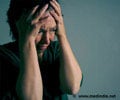A recent study finds that fewer Americans may be feeling the blues, with rates of depression in people over 50 on the decline.

The nationally representative study appears in the Journal of General Internal Medicine.
"Over that decade, we saw a significant decrease in depression among older adults, and we need further studies to explore whether this is the result of improved treatment," says lead author Kara Zivin, Ph.D., assistant professor of psychiatry in the U-M Medical School and research investigator at the VA Center for Clinical Management Research.
"Even with signs of progress, however, a significant percent of our population is still experiencing severe symptoms of depression, and we need to do more to ensure all of these groups have proper access to treatment."
Late-life depression has been a major area of concern among health providers, with studies showing increased depression at a time when many face death of loved ones, isolation, medical problems or changes in economic status. The new study, however, suggests improvements in this trend, with the most pronounced drop in depressive symptoms in people in the 80-84 age group.
Increase in depression rates were concentrated among people in late middle age between ages 55-59 – a group that hasn't traditionally been focused on as an at-risk group.
Advertisement
Researchers used data from the Health and Retirement Study, a nationally-representative sample of older Americans that is conducted by the U-M Institute for Social Research on behalf of the National Institute of Aging.
Advertisement
Source-Eurekalert









